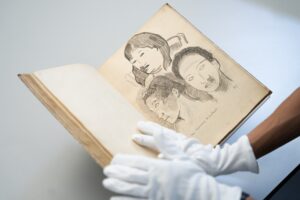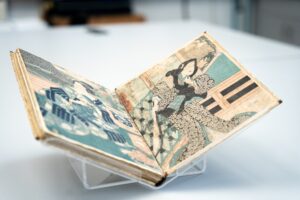
News Archive 2021
Avant et après – blog
By Dr Ketty Gottardo (MA 2004, PhD 2012), Martin Halusa Curator of Drawings
In 2020, The Courtauld acquired one of Paul Gauguin’s most important manuscripts, which has rarely been seen and was long thought to be lost.
The last major manuscript by the artist, it was acquired by The Courtauld through the Government’s ‘Acceptance in Lieu’ scheme administered by the Arts Council. Written in 1903, in the last few months of Gauguin’s life when he was living in the South Pacific, Avant et après (which means ‘Before and after’) is part-memoir and part-manifesto. In more than 200 pages comprising 18 monotypes and 10 pages of drawings, the work reveals fundamental insights into Gauguin’s life, and complements the extraordinary collection of Gauguin’s works at The Courtauld.

The entry of Avant et après into a UK public collection is the most important development in Gauguin studies in recent memory. No Gauguin scholars knew where the manuscript was; certainly, few people could have imagined that it was in the UK. Now part of the collection of The Courtauld, it has found here a fitting home. Through its holdings, which include Gauguin’s Tahitian masterpieces Nevermore (1897) and Te Rerioa (1897), The Courtauld provides a rich context for the manuscript and ensures that it is accessible to scholars and the general public alike. Samuel Courtauld’s biography and taste seem to echo in many ways those of Erich Goeritz (1889-1955), who acquired Avant et après in the 1920s and in whose family it had remained since.

By remarkable coincidence, The Courtauld’s most famous painting, Édouard Manet’s A Bar at the Folies-Bergère (1882) once belonged to Goeritz, the last private owner of the work before Samuel Courtauld. When The Courtauld Gallery reopens in November 2021, Avant et après will be displayed in the Great Room alongside many of the Impressionist and Post-Impressionist works.
What is Avant et après? The title, which Gauguin has inscribed on its cover, is generally interpreted to indicate that the text expands on his life before and after he moved to the South Pacific, to Hiva Oa, one of the Marquesas islands. Though born in France, where he spent most of his life, Gauguin was somewhat of a globetrotter. Having spent part of his childhood in Peru, he then travelled the world as a member of the merchant marine, and lived in Denmark, Martinique, and Tahiti. Written in a volume about the size of an A4 sheet, this highly complex work resonates as the artist’s own testament, and represents the culmination of Gauguin’s literary endeavours.
In addition to anecdotes about Gauguin’s friendships and opinions on the work of leading contemporary artists such as Degas, Pissarro, Signac and Cézanne, Avant et après is studded with examples of his opinions on literary figures and caustic comments on those art critics who did not understand (or appreciate) the modernity of his art. Gauguin’s hatred of hypocrisy and bourgeois morality is a constant theme. The text also includes excoriating attacks on the French colonial and church authorities in Polynesia, whose hypocrisy and corruption Gauguin condemned for ruining the lives of indigenous Polynesians. However, many passages also display unforgiving examples of Gauguin’s own exoticist racial and sexual stereotyping.

Though the reappearance of the volume is recent, the manuscript was known through a facsimile published in 1918, as well as several reprints of the first transcription (1923) and English and German translations. None, however, gave an accurate account of it. Gauguin’s fascinating drawings and prints in the manuscript have also been understudied. Three Japanese prints by Utagawa Kunisada (1786- 1864), which Gauguin had pasted down inside the cover, were previously published in black and white, and were previously unidentified. Most revelatory are the drawings which the artist executed on the back of the monotypes, which are unpublished. They will be photographed and made digitally available, so that they can be studied and shared with the public to better inform Gauguin’s artistic practice.
One of the key sections in the manuscript reflects on the brief yet tumultuous period when Gauguin lived and worked with Vincent Van Gogh in Arles. Gauguin describes the incident in which Van Gogh severed his own ear (represented in Van Gogh’s 1889 Self-Portrait with Bandaged Ear at The Courtauld) after a violent quarrel with his fellow artist, a passage that was long regarded as the primary source of information about that fateful and infamous event. Over a decade after the fact, Gauguin looked back on his relationship with the Dutch artist, perhaps in an effort to exculpate himself from the accusations that surrounded him as Van Gogh’s posthumous reputation grew in the early 20th century.
Come and take a closer look at Avant et après, which will be housed in The LVMH Great Room when the Gallery reopens in November 2021. Friends go free – find out more at courtauld.ac.uk/friends